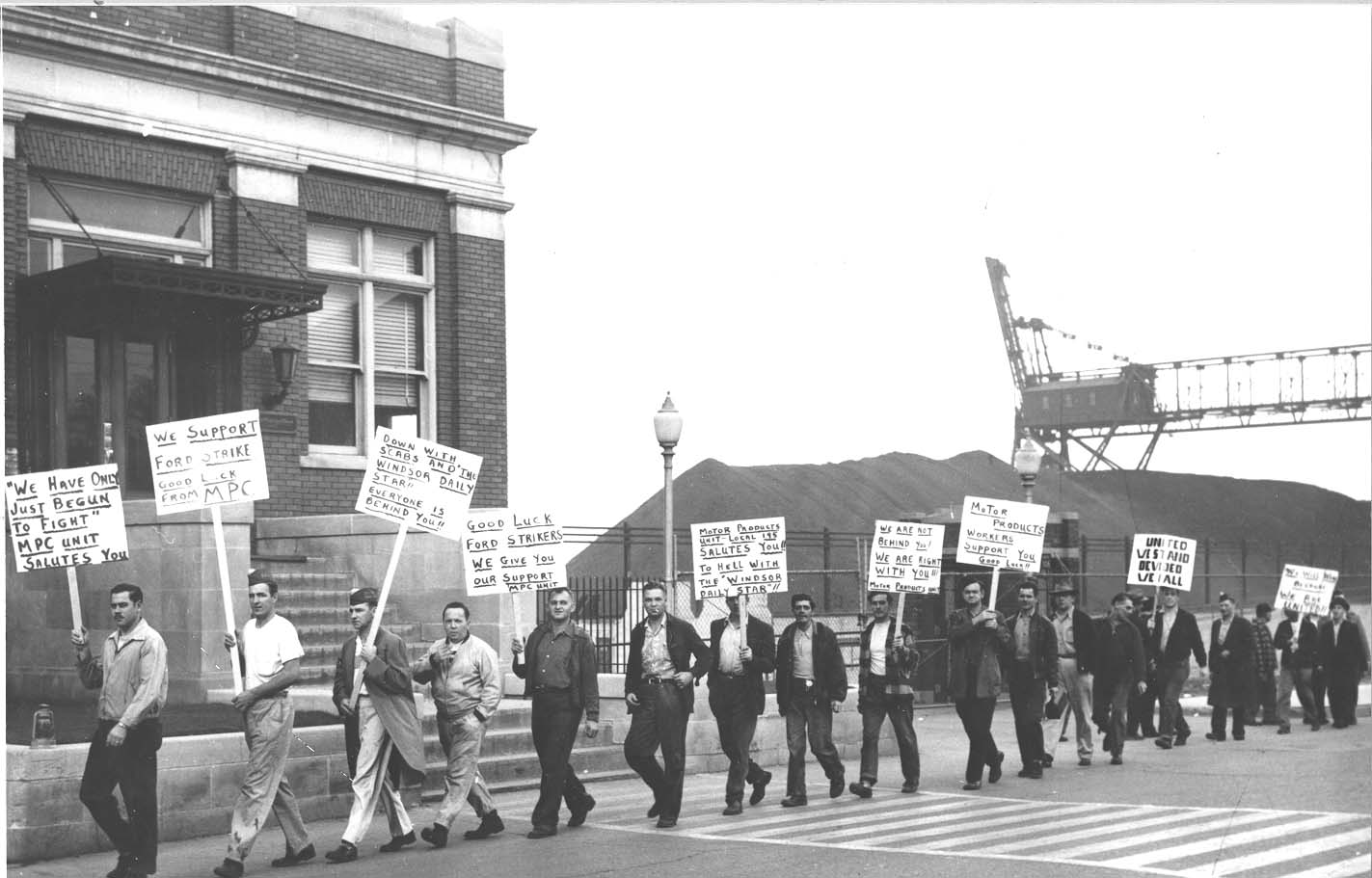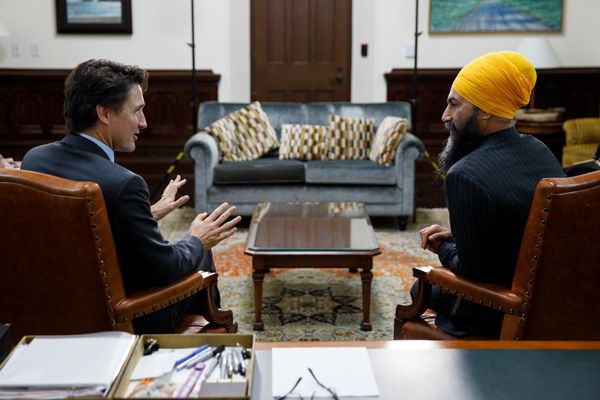Comparisons between the coronavirus pandemic and the Second World War have become commonplace in recent weeks.
In Canada, writers have highlighted the wartime lifestyle of reduced consumption and civic sacrifice, the necessity of emergency deficit spending, and government-directed industrial production. In one of his daily addresses, Prime Minister Justin Trudeau made the comparison explicitly, stating, “Canada hasn’t seen this type of civic mobilization since the Second World War.”
Writing in Maclean’s, Frank Graves and Michael Valpy optimistically call for a renewed investment in social programs as a result of this crisis: “It’s what happened at the end of the Depression and at the end of the Second World War as western governments embraced policies to reduce inequality, to bring relief for the unemployed and poor, to use the power of the state to build the welfare state while reforming the financial system and help the economy recover.”
Missing from this picture of Canada’s wartime, however, is a discussion of the domestic politics that made welfare reforms possible. During the Second World War, Liberal Prime Minister William Lyon Mackenzie King legislated several welfare state policies, including unemployment benefits, family allowances and labour law. Without significant pressure from the Canadian left, however, these advances likely wouldn’t have come to pass.
If COVID-19 provides a similar opportunity for the advancement of social policy, the Canadian left will have to fight for it to be realized.
The Second World War And The Welfare State
Canada’s economy was in rough shape at the outset of the Second World War. Throughout the Great Depression, mass unemployment ravaged the workforce, and drought in the prairies left many farmers destitute. From 1929 to 1932, net national income fell from $4.7 billion to $2.4 billion. Meanwhile, relief for the poor was a patchwork of inadequate programs financed by provinces and municipalities, which each had limited fiscal capacities. In 1933, Canada’s unemployment rate hit 30 per cent, with only about half of those without jobs receiving any benefits at all, as unemployment insurance didn’t exist.
“The Dirty Thirties,” however, was also “The Red Decade,” as the Depression’s widespread misery fuelled the growth of the political left. In 1932, the Co-operative Commonwealth Federation (CCF) was founded in Calgary, combining elements of progressive farmers’ parties, organized labour and a socialist intelligentsia. The party leader was J.S. Woodsworth, a former social gospel minister and Manitoba member of parliament of the Independent Labour Party. In the words of the Regina Manifesto, their founding charter, “No CCF government will rest content until it has eradicated capitalism.”
Along with welfare programs such as unemployment benefits, the CCF proposed replacing private enterprise with social ownership, and controlling markets through economic planning. The party grew during the decade, partly through an extensive and lively network of local reading and discussion clubs. At the same time, the Communist party in Canada gained influence, especially within the trade unions and among the unemployed.
Throughout the 1930s, the theories of John Maynard Keynes, which counselled government deficit spending to “prime the pumps” of a slumping economy, gained international influence. While Canadian socialists sought increased public spending as well, Keynesianism was slow to infiltrate King’s Department of Finance. Unlike United States President Franklin Delano Roosevelt, King tended to remain faithful to classical liberal policy of debt avoidance and low taxes. A 1935 book by the CCF-affiliated think tank League for Social Reconstruction, Social Planning for Canada, laments with remarkable prescience, “It will be the mocking irony of our economic system if it presents as the ultimate, moral, ‘Christian’ solution for unemployment — another war.”
Only in 1939 did Canada propose its first Keynesian budget — the existential threat of the war finally forced the government’s hand. With the private sector weak, the public sector had to lead the way in meeting the demands for manufactured goods and raw materials sparked by the war. The Department of Munitions and Supply oversaw all industrial production, eliminating competition among firms for scarce resources. Where private enterprise couldn’t be coaxed to produce in an efficient and timely manner, Crown Corporations were established — 28 in all during the war. To avoid the inflation and profiteering that had happened during the First World War, price controls were implemented and taxes raised. Corporate taxes were more than doubled, and an excessive profits tax clawed back corporate earnings exceeding pre-wartime levels.
These measures resembled the nationalization and economic planning the CCF had been proposing for years, and they proved tremendously productive and efficient. Canada’s GDP doubled between 1939 and 1945, with full employment being reached in 1941, and further labour in high demand. From 1938 to 1943, average wages grew by 50 per cent.
To drive war recruitment, the federal government offered enlisting men generous benefits, including pensions, healthcare, job guarantees, preference for civil service positions, free university education and vocational training. As the war dragged on, the entitlements and benefits offered to servicemen grew even further, becoming a major investment in the post war populace.
The publicly owned Bank of Canada was also key to funding the war effort. The bank bought the government’s own securities, providing 25 per cent of domestically raised dollars during the first 22 months of the war. The Bank of Canada also used chartered banks to finance Canadians’ purchases of Victory Bonds, essentially allowing the government to raise money from citizens to whom it had itself, in a roundabout way, loaned the money. Later in the war, as wages increased, the government kept inflation low by selling further Victory Bonds, taking money out of circulation and putting it toward war expenditures.
In 1940, the Liberal government also finally established an unemployment benefit. A constitutional amendment regarding taxation jurisdiction was required, but with war raging all premiers agreed. The CCF had championed a universal unemployment benefit that would be available to all Canadian workers. However, the Liberal benefit — essentially the EI program we have today — was based on employee and employer contributions. Only workers who had paid enough into the benefit and fulfilled other criteria were eligible. With full employment during the war, however, King understood few would access unemployment, and crucially, the unused fund would be folded into the government budget for any other expenditure — a trick still played today when the fund runs a surplus. Regardless, many Canadian workers in 1940 enjoyed some protection from the unemployment that had ravaged them during the Depression.
The Rise Of The CCF
With full employment, union membership exploded, doubling in the years between 1939 and 1945. As labour was in high demand, these workers and unions flexed their muscles: In 1943, one in every three union members in Canada was on strike. With the Communist Party declared illegal in Canada in 1940 and de-radicalized by Comintern orders, the democratic socialist CCF became the more militant force in the unions, engineering a union merger that created the powerful Canadian Congress of Labour (CCL).
Along with cultivating support in the unions, the CCF surged in the polls. History was proving their policies of economic planning and social ownership correct, and the civic spirit produced by the war lent itself to feelings of social solidarity. Working-class Canadians, too, feared a return to Depression conditions after the war — as had happened in 1918 — and they sought material and political advancements while they could.
In 1941, the CCF won a plurality of votes in British Columbia and formed the official opposition. In 1942, a little-known CCF candidate running in a by-election unseated the head of the federal Conservative party, Arthur Meighen. In 1943, the CCF narrowly missed forming a government in Ontario, bounding to 31 per cent of the vote from only 5 per cent in the previous election. Later that year, a Gallup Poll showed the CCF leading both the Liberals and the Conservatives nationally. In 1944, CCF member Tommy Douglas was elected premier of Saskatchewan, the first time a democratic socialist party formed a government in North America.
This unprecedented popularity of the left rattled the two older parties. The Conservatives added “Progressive” to their name and declared support for modest welfare state proposals. King felt especially threatened. As historian Ivan Avakumovic points out in his book Socialism in Canada, late in the war “Mackenzie King devoted many of his undeniable talents to thwarting the CCF and preventing the desertion of Liberal voters to the democratic socialists.” King also had to counter, in his own words, the “threat of defections from our own ranks in the House to the CCF.”
Liberal Co-option
In his diaries and behind the scenes, King worried about the growing electoral strength of the CCF. Publicly, however, he appeared conciliatory to CCF demands, borrowed from their policy playbook and courted their major figures.
In 1942, following the Beveridge Report in the United Kingdom that had recommended a slate of social welfare programs to avoid a post-war depression, the federal Liberals commissioned a similar report from Leonard Marsh, a McGill University researcher and a prominent CCF-affiliated intellectual.
Marsh recommended a panoply of social programs, and within weeks the Liberal Advisory Council drafted them into a 14-point program of touted reforms. Ultimately, most of this report would be ignored by the government, but before the upcoming 1945 election, King decided to implement one of them: family allowances, or what today is known as the Child Benefit.
Soon thereafter, a monthly payment of $5 to $8 per child provided 10 to 20 per cent of total income for an average Canadian family, although these payments weren’t indexed to inflation so their value quickly diminished. Importantly for the Liberals, family allowances were also supported by business interests since this benefit reduced wage demands made by workers.
The family allowances, in effect for the 1945 election, bolstered Liberal credibility on social welfare by using a CCF proposal. As King wrote in his diaries, “I think I have cut the ground in large part from under the CCF.”
To curry favour with unions and to promote labour’s cooperation during the war, in 1944 King passed Order in Council P.C. 1003, which established collective bargaining rights and protected against employer interference in unionization. On one hand, the landmark legislation provided a framework for labour relations in the prosperous post-war years when union membership expanded and saw many material gains. On the other, the law imposed a system of bargaining and grievance that invested tremendous power in the union bureaucracy, which over time, alienated and demobilized the rank and file. In any case, in the 1945 election, the Liberals passed labour legislation that likely won them many unionized voters.
In another direct attempt to decapitate the surging CCF in advance of the 1945 election, King offered M.J. Coldwell, the head of the federal CCF, a position as deputy leader in a coalition government, meaning he’d also be the prime minister’s likely successor. While the offer must have been tempting, Coldwell didn’t enter coalition governments in principle, and likely understood this as a Liberal attempt to neutralize the CCF’s challenge. Coldwell also had good reason to believe his own party was about to be elected into government.
The 1945 election, however, was a disappointment for the CCF. They took just 15 per cent of the vote and 28 seats, while the Liberals scored 40 per cent, enough for a strong minority government. The Liberals had promised “womb to tomb” social security, including universal healthcare and pensions — promises King would indeed break. Their slogan, “A New Social Order for Canada,” could have been cribbed from a CCF pamphlet. Riding a booming economy, and having passed enough social policy to seem credible, the Liberals stole the CCF’s thunder.
The CCF, meanwhile, already suffered under the immense weight of Red Scare propaganda in these opening months of the Cold War, spearheaded earlier in the year by Ontario Conservatives during their provincial election. The CCF couldn’t be trusted, critics claimed, to preserve civil liberties. Socialism was likened to fascism for its plans to bring the economy under government control. The Overton window on socialism was rapidly closing. The words “socialist” and “socialism” disappeared from CCF election literature. The CCF’s most transformative policy promises, social ownership and economic planning, were made to seem like unnecessary risks to voters.
As the Cold War chill deepened and the post-war prosperity continued, the CCF’s electoral fortunes declined further. The party saw its regional base in the west erode, and at the same time failed to make inroads with the growing working class. In 1956, a revamp to CCF principles in “The Winnipeg Declaration” moderated their anti-capitalist language.
After their 1958 election nadir, which saw only eight CCF members re-enter parliament, the party completed its rebranding. In 1961, the CCF became the New Democratic Party, which was more closely allied to unions for funding and organizational support. While continuing to demand more generous social benefits, the NDP, perhaps necessarily given the times, rejected widespread nationalization of industry and economic planning, the former bedrock of CCF policy.
A Modern Opportunity For The Left
The Second World War illustrates the importance for left parties and labour unions of acting as pressure groups during a crisis. During the COVID-19 crisis, the federal NDP has thus far advocated making the $2,000 per month Canada Emergency Response Benefit (CERB) universally available, likely influencing the Trudeau government’s widening of eligibility to include some students and low-wage workers. While the CERB is still unavailable to more than a million jobless Canadians, progress is being made. Unions have negotiated for better pay and safety for workers exposed to risks from COVID-19, and workers have walked off the job demanding safer conditions. If not yet mid-century levels of mobilization, these are encouraging signs.
The CERB benefit, too, has renewed calls for a universal basic income (UBI) as millions of Canadians have lost their jobs. If the economy fails to restore employment as COVID-19 lingers, the Liberal government might see a huge political risk in withdrawing this benefit, as many of their voters have come to depend on it to survive. There will certainly be renewed calls for austerity from the right, manufacturing panic over debt and deficits. But it’s possible COVID-19’s legacy in Canada will be some kind of UBI. That significant sectors of capital have endorsed a UBI make this possibility all the more real.
It will be the task of the left, however, to push for a UBI and associated legislation that maximizes the benefits to ordinary Canadians, and doesn’t simply become an indirect subsidy to rent-raising landlords and wage-slashing employers, nor provide cover for cutting other public expenditures. The left will also have to drag the Liberals toward more public ownership and economic planning. Shortages of personal protective equipment and ventilators have produced some governmental response, but this has been limited to incentives for private manufacturers in Canada.
For the post-pandemic recovery, the Liberals are planning to kick into gear their dubious Infrastructure Bank, which has been rightly criticized as an expensive privatization scheme. Instead, the left should push for public sector employment designed to produce for public need, not private profit, because it’s simply more efficient. As economist Jim Stanford points out in the Progressive Economics Forum, in the long term, “Canada’s economy will need to rely on public service, public investment, and public entrepreneurship as its main ‘engines’ of growth, to recover from the coming downturn, prepare for future health and environmental crises, and improve conditions in our communities.”
Of course, certain business interests will likely resist any attempt to expand the economy outside of the private sector, and their influence on the Liberals will be considerable. But the numerous Crown corporations created during the Second World War proves large-scale public employment can be achieved quickly and successfully, and should provide inspiration for this undertaking.
In their book, Make This Your Canada, released in 1943 while the socialists still rode high in the polls, CCF intellectuals David Lewis and Frank Scott explain that transformative change requires democratic control and ownership of the economy, including “a cooperative organization of industry to make possible planning by the people for the people.”
They understood, too, that welfare reforms don’t amount to socialism, but the real material gains won through reforms, in the more recent words of Leo Panitch, Sam Gindin and Stephen Maher in Socialist Register, “weaken the power of corporations over working-class lives and challenge the logic of competitiveness and profitability,” making room for “further socialist possibilities.”
Perhaps the current crisis, as the Second World War did, presents these possibilities.







Member discussion